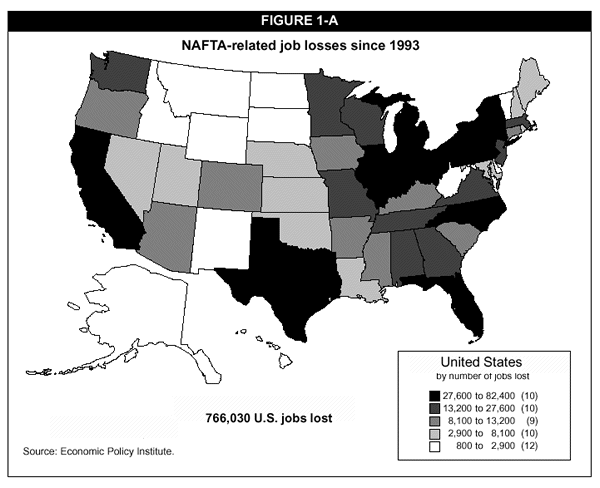A weekly presentation of downloadable charts and short analyses designed to graphically illustrate important economic issues. Updated every Wednesday.
Snapshot for April 11, 2001.
NAFTA-related job losses in every state
NAFTA supporters have frequently touted the benefits of exports while remaining silent on the impacts of rapid import growth (see EPI Issue Brief #139). But any evaluation of the impact of trade on the domestic economy must include both imports and exports. If the United States exports 1,000 cars to Mexico, many American workers are employed in their production. If, however, the U.S. imports 1,000 foreign-made cars rather than building them domestically, then a similar number of Americans who would have otherwise been employed in the auto industry will have to find other work. Ignoring imports and counting only exports is like trying to balance a checkbook by counting only deposits but not withdrawals.
The U.S. has experienced steadily growing global trade deficits for nearly three decades, and these deficits have accelerated rapidly since NAFTA took effect on January 1, 1994. Although gross U.S. exports to its NAFTA partners have increased dramatically-with real growth of 147% to Mexico and 66% to Canada-these increases have been overshadowed by the larger growth in imports, which have gone up by 248% from Mexico and 79% from Canada. As a result, the $16.6 billion U.S. net export deficit with these countries in 1993 increased by 378% to $62.8 billion by 2000 (all figures in inflation-adjusted 1992 dollars). As a result, NAFTA has led to job losses in all 50 states and the District of Columbia, as shown in the figure below.

The U.S. lost 766,030 actual and potential jobs between 1993 and 2000 (see NAFTA’s Hidden Costs from the report NAFTA at Seven). With exports from every state being offset by faster growth in imports, net job loss figures range from a low of 395 jobs lost in Alaska to a high of 82,354 in California. Other hard-hit states include Michigan, New York, Texas, Ohio, Illinois, Pennsylvania, North Carolina, Indiana, Florida, Tennessee, and Georgia, each with more than 20,000 jobs lost. These states all have high concentrations of the kinds of industries (motor vehicles, textiles and apparel, computers and electrical appliances) that subsequently have expanded rapidly in the maquilidora zones in Mexico since the implementation of NAFTA.
This week’s Snapshot by EPI economist Robert E. Scott.
Check out the archive for past Economic Snapshots.
